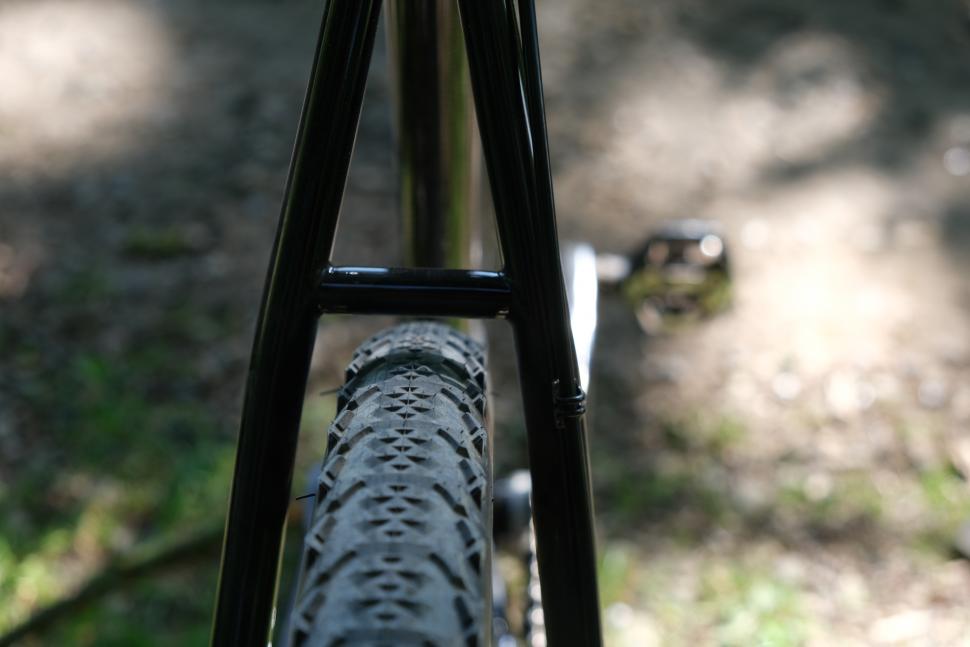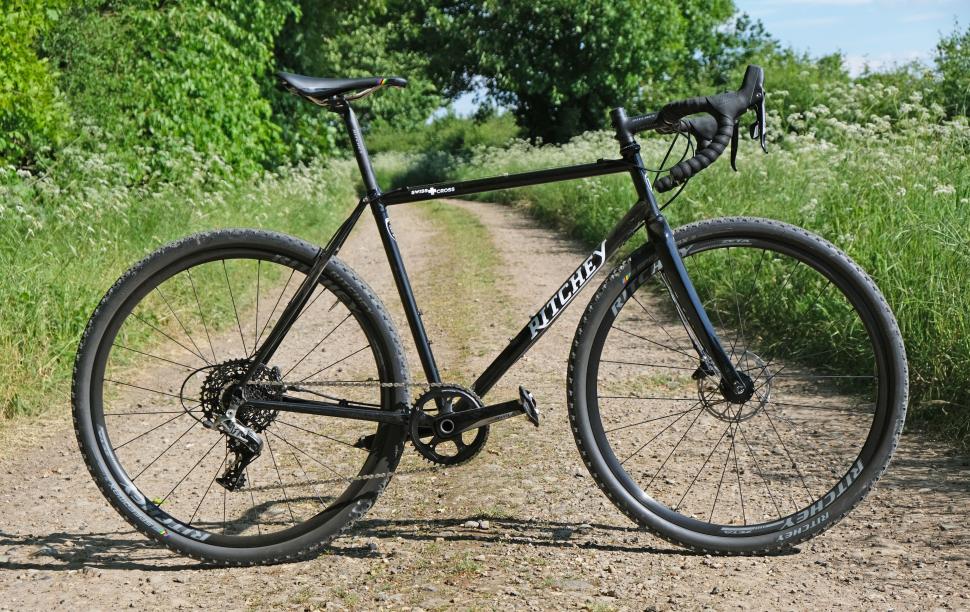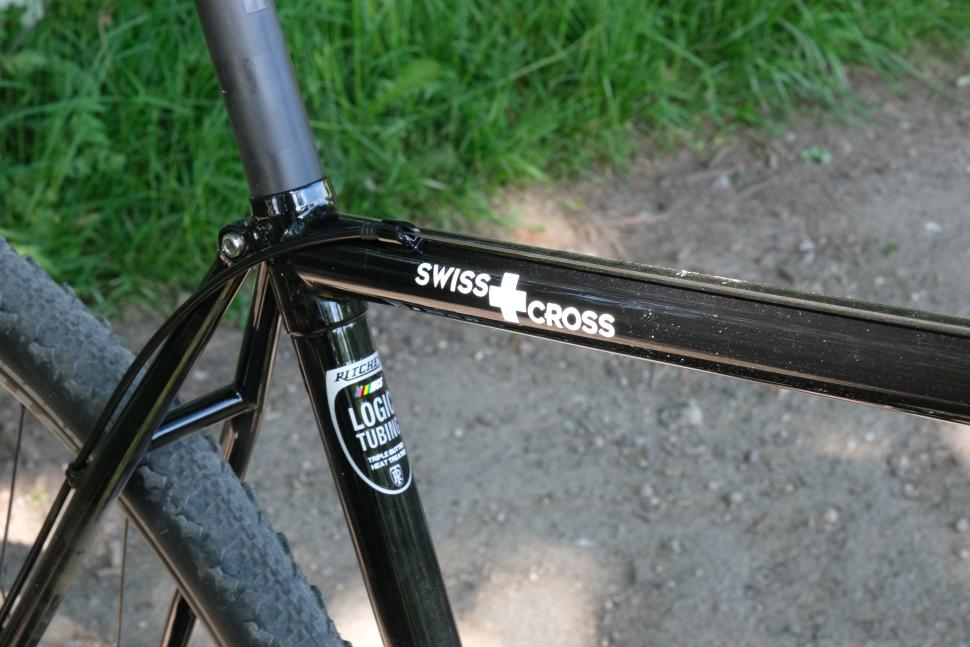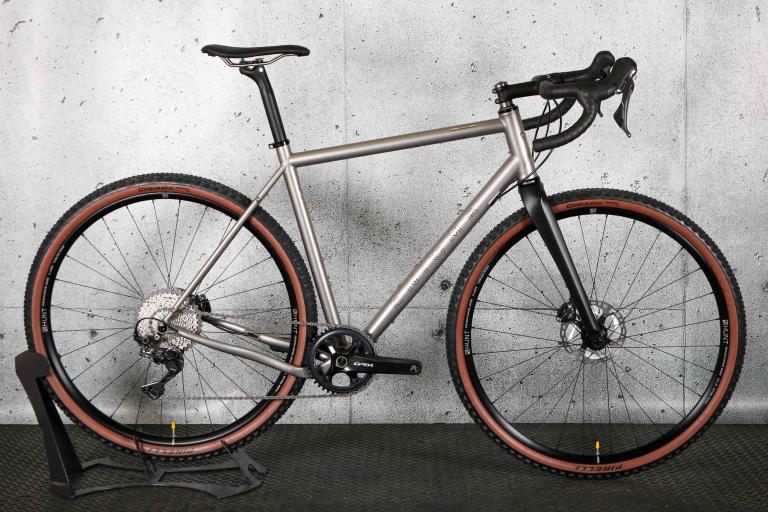- News
- Reviews
- Bikes
- Accessories
- Accessories - misc
- Computer mounts
- Bags
- Bar ends
- Bike bags & cases
- Bottle cages
- Bottles
- Cameras
- Car racks
- Child seats
- Computers
- Glasses
- GPS units
- Helmets
- Lights - front
- Lights - rear
- Lights - sets
- Locks
- Mirrors
- Mudguards
- Racks
- Pumps & CO2 inflators
- Puncture kits
- Reflectives
- Smart watches
- Stands and racks
- Trailers
- Clothing
- Components
- Bar tape & grips
- Bottom brackets
- Brake & gear cables
- Brake & STI levers
- Brake pads & spares
- Brakes
- Cassettes & freewheels
- Chains
- Chainsets & chainrings
- Derailleurs - front
- Derailleurs - rear
- Forks
- Gear levers & shifters
- Groupsets
- Handlebars & extensions
- Headsets
- Hubs
- Inner tubes
- Pedals
- Quick releases & skewers
- Saddles
- Seatposts
- Stems
- Wheels
- Tyres
- Health, fitness and nutrition
- Tools and workshop
- Miscellaneous
- Buyers Guides
- Features
- Forum
- Recommends
- Podcast
£1,260.00
VERDICT:
Silky smooth steel cyclo-cross bike but not without its limitations
Weight:
2,700g
Contact:
At road.cc every product is thoroughly tested for as long as it takes to get a proper insight into how well it works. Our reviewers are experienced cyclists that we trust to be objective. While we strive to ensure that opinions expressed are backed up by facts, reviews are by their nature an informed opinion, not a definitive verdict. We don't intentionally try to break anything (except locks) but we do try to look for weak points in any design. The overall score is not just an average of the other scores: it reflects both a product's function and value – with value determined by how a product compares with items of similar spec, quality, and price.
What the road.cc scores meanGood scores are more common than bad, because fortunately good products are more common than bad.
- Exceptional
- Excellent
- Very Good
- Good
- Quite good
- Average
- Not so good
- Poor
- Bad
- Appalling
Time doesn't stand still in the cycling world. The 25th anniversary Ritchey Swiss Cross might be showing its age in appearance, but when it comes to riding the performance is first class, with a truly silky smooth quality and good handling. It's still a cyclo-cross race bike at heart, but this updated version with improved clearance for 40mm tyres does open it up to more adventurous riding, though it doesn't offer the versatility we're rapidly coming to expect from modern gravel and adventure bikes.
- Pros: Smooth, fast, comfortable, splendid looks, heritage and history
- Cons: For adventuring – no extra mounts for bottles and mudguards and limited tyre clearance
> Find your nearest dealer here
Ride and handling
Smooth. Smooth. Smooth. That is the immediate and lasting takeaway from riding the Swiss Cross. It's one of the nicest steel bikes I've ridden and is a good reminder that steel is still a valid choice in the face of more modern material choices.
We all know steel offers a smooth ride quality, of course, it's been drilled into us for decades, but there's importance not just in the tube selection but in how the tubes are joined, and all the small details that clearly mark the Ritchey as being smoother than other steel bikes I've tested.
The Swiss Cross was born for the highest level of cyclo-cross race 25 years ago, but it would never be used at the same level today. (Though it would be fascinating to see someone like Mathieu van der Poel swap his carbon Canyon for the Swiss Cross for one round of a CX race. I'm sure he'd still win!)
At my level, many many rungs below the Dutch wonder kid, the Swiss Cross is fast. Not the sort of scintillating turn of speed you expect from a super-stiff carbon race bike, but it gets a real shift on when you get the SRAM cranks spinning. The extra weight is not as apparent on the trail as it is on paper – it's only when you sling it over your shoulder that you notice it – through the turns and down the straights the Ritchey blasts along very nicely indeed. It's not going to hold you back that's for certain.
The increased tyre clearance of this latest model widens the appeal of the Swiss Cross away from the lactic acid hell of cyclo-cross racing to wide open gravel adventures and bridleway bashing, something I do a lot of these days. It's incredible how much these bikes have expanded my horizons to the miles of forgotten woodland trails, byways and paths in and around the Cotswolds.
The wonderful smoothness is impressive, whether it's a rough old country lane with grass growing down the middle or a rutted dirt track along the edge of a farmer's field. With the fast-rolling WCS Speedmax tyres a good match for the dry and dusty conditions during the test period, the Ritchey was a good partner for some long distance roads with a higher percentage of off-road tracks than tarmac roads.
My fit and position felt good on the bike and the changes to the geometry, particularly the longer reach, lower bottom bracket and long 437mm chainstays, ensure a good level of surefootedness when bouncing along dried-out riverbeds or tackling high-speed descents littered with obstacles, some stationary (rocks and roots) and others moving (pheasants and squirrels!).
It's not a super-nimble bike that gets all your synapses firing when the turns are coming thick and fast. It's not as razor-sharp as some modern carbon cyclo-cross race bikes, but it can keep up with your demands pretty well, with good steering responses. It also doesn't feel at all hamstrung by the skinny non-tapered head tube, despite what its appearance might suggest.
Frame details
The frame is beautifully constructed from Ritchey's own Logic triple butted steel tubing, with the neatest attention to detail I think I've ever seen, and smooth brazing and TIG welding. Everything is external, from the bottom bracket to the cable and brake hose routing, and the traditional seat clamp at the top of the seat stays.
Nicely matching the skinny steel tubes is a non-tapered 1 1/8in steerer tube with a full carbon fibre fork. It perhaps looks out of place against the oversized and tapered head tubes we're so used to seeing on carbon and aluminium bikes, but it matches the frame well with elegant proportions.
The Swiss Cross was previously available with disc brakes, but it's been updated with 12mm thru-axles front and rear and flat mount callipers rather than the quick release and post mount of the old bike. To accommodate the disc brakes there's a new carbon fork and out back a lovely forged dropout to integrate the thru-axle and flat mount interface. You can fit a 140mm rotor at the back, and 140 or 160mm up front.
While it was carrying out the updates to the Swiss Cross, Ritchey also gave the geometry a slight revision. Most of the numbers are carried over, like the 72-degree head angle, but the chainstays are longer to make space for the wider tyres, the reach is now longer, the stack lower, and the bottom bracket lower, all changes that contribute to good stability. My fit and position felt good on the bike and I didn't need to make any changes.
There are six sizes to choose from: XS to XXL, with the smaller sizes getting more sloping top tubes for better standover for shorter riders.
While the wider tyre clearance certainly helps to broaden the Swiss Cross's appeal to cyclists not only interested in cyclo-cross racing but more likely leisure rides and gravel exploring, it's not without its drawbacks compared with more modern and versatile bikes in this category. There are only two bottle cage mounts and no mudguard eyelets, so it's clip-on 'guards if you want to ride it through the winter or use it for commuting or touring.
And yes, the 40mm tyre clearance is appreciated, this being the sweet spot for most UK gravel riding terrain, but in my opinion the space around the tyres, particularly at the fork, is extremely tight.
There's little room for mud and debris to clear and this will be a bigger problem in winter when mud is omnipresent, and you'll likely have to go down to a narrow knobbly tyre to get the traction and clearance you really need.
Equipment
The frame and fork cost £1,259 so it's up to you to build the bike up yourself. Ritchey kindly built us a bike so we could review the frameset and gave us a chance to ride some new Ritchey components, from the wheels to the handlebar.
The build on this test bike centred around a SRAM Rival 1 groupset, something we're well used to here at road.cc. It provides plenty of range for racing and adventure riding, you can easily swap the chainrings to customise it for your requirements, and the hydraulic brakes work a dream. The frame is 2x compatible too, and there are cable stoppers for adding a mechanically operated front mech on the down tube.
Moving on to the rest of the kit and it's all about the Ritchey branded parts. Let's start with the Zeta Comp Disc wheels because they are brand new.
They're a new value-conscious wheelset priced at £260 but don't skimp on details, using Ritchey's previous generation WCS hub along with new aluminium tubeless-ready rims. The rims use an Off Center Rim (OCR) to balance spoke tension for a stronger and stiffer wheel, and have a 19.5mm internal rim width.
The hubs are forged aluminium with sealed bearings, two in the front and four in the back, and are laced together with 24 DT Swiss spokes and brass nipples. They weigh a claimed 1,750g for a set, which is what you expect at this sort of price. They're also made by hand.
All finishing kit is Ritchey WCS equipment including a brand new Butano Bar. It's 'a homage to the early days of off-road and mixed terrain riding' and combines a 118mm shallow drop with a 73mm reach, a 12-degree flare in the drops and a 4-degree back sweep on the tops. It's made from 7005 aluminium and weighs a claimed 275g for a 42cm.
It's a very comfortable handlebar, with the sweep providing a nice reach to tops and the slightly flared drops giving a bit of added wrist clearance as well as improving control on loose terrain.
A Ritchey WCS aluminium stem, carbon seatpost and comfortably shaped saddle complete the build for an all-up weight of 9.8kg for the size large test bike.
Rivals
If you're in the market for a cyclo-cross bike you are spoilt for choice, but the selection narrows considerably if you want a steel frame. Look through the road.cc review archive and it's mostly carbon fibre and aluminium options, but there is the Light Blue Robinson, now £1,699 for the SRAM 1x build, and for less racy ambitions the Surly Straggler could be an option, at £650 for the frameset (we tested one back in 2014).
> Buyer's Guide: 14 of the best cyclo-cross bikes
Given that the tyre clearance edges the Swiss Cross into the category of adventure and gravel bikes there is more choice here, but because the Ritchey doesn't have the same wide versatility, it makes direct comparison a little difficult.
> Buyer's Guide: 22 of the best gravel & adventure bikes
Sticking with steel, one obvious rival is the Fairlight Cycles Secan, which features a steel frame with much wider tyre clearance and more versatility, from extra bottle mounts to mudguard and rack eyelets. It's £1,099 for the frameset. Another choice could be the Condor Gravel Stainless, a high-quality steel frameset with clearance for 40mm tyres – but it'll set you back £3,599.99 for the frameset.
Even Ritchey's own Outback, a more laid back version of the Swiss Cross, doesn't boast the sort of versatility that might be expected of a modern adventure bike.
Conclusion
I love the Ritchey Swiss Cross for its heritage and sublime ride, and traditional timeless aesthetic, and the modernising changes will be appreciated by those who want to do more than just race around a muddy field on a Sunday afternoon. But as lovely as it is, unless you're a big Ritchey or steel frame fan, it's hard to see why you would choose this bike over racier CX bikes or more versatile gravel bikes.
Verdict
Silky smooth steel cyclo-cross bike but not without its limitations
If you're thinking of buying this product using a cashback deal why not use the road.cc Top Cashback page and get some top cashback while helping to support your favourite independent cycling website
road.cc test report
Make and model: Ritchey Swiss Cross Frameset
Size tested: Large
Frameset
Tell us what the frameset is for, and who it's aimed at. What do the manufacturers say about it? How does that compare to your own feelings about the bike?
Ritchey says, "Possibly the most iconic frame associated with Ritchey, the Swiss Cross draws its name from early factory rider, cyclocross and mountain bike legend Thomas Frischknecht. The first iteration of the Swiss Cross was a no-holds-barred race machine designed for one thing: ripping through dirt like no other. Captained to numerous victories under Frischi, the Swiss Cross went on to become one of the most revered frames of the Ritchey offering.
"Twenty-five years later, the Swiss Cross is still a staple of the Ritchey fleet - now featuring modern standards such as 12mm thru-axles, flat-mount brakes, and higher-volume tire clearance. Yet one thing has remained unchanged: it is still a no-holds-barred race-ready dirt ripper. Whether it's leading the charge on bell lap or ticking off the grueling miles of a gravel grinder, the new Swiss Cross is more than capable of tackling it all.
"In honor of its 25th anniversary and namesake, Ritchey has created 100 limited edition framesets, crafted in homage the frame Frischi rode to European Cyclocross Championships. Each frame is numbered for added uniqueness and ships with a special miniature cowbell that attaches to the handlebar."
State the frame and fork material and method of construction
Ritchey lists these details:
Handmade to Tom Ritchey's exacting standards
Updated modern sloping top tube Cyclocross geometry
Sizes XS-XXL
Heat treated, triple-butted Ritchey Logic II™ CrMo steel tubing throughout
Forged and machined head tube with integrated cups for use with drop-in headsets – lighter and stronger than a standard head tube
Straight carbon steer tube with optimized layup for stiffness under braking forces without excessive harshness
Ritchey WCS monocoque fravel thru-axle fork, painted to match
Full-length housing stops for use with cable or hydraulic brakes
Front: 140/160mm rotor compatible; Rear: 140mm rotor compatibility
Flat mount disc caliper compatibility
Ritchey forged 12mm thru-axle rear dropouts; 12mm thru-axle front
142mm rear spacing
Room for tires up to 40c (depending on tire and rim manufacturer)
Includes: frame / fork / WCS headset / axles
28.6 front derailleur clamp (Caution: Front derailleur clamp MAX torque of 2.5Nm)
Weight: 2700g / 5.95 lbs (L – frame / axle / hanger)
Colors: Heritage Red/White, Black
Overall rating for frameset
10/10
Tell us about the build quality and finish of the frame and fork?
Beautifully made from the company's own Logic triple butted steel tubing with lots of very sensible and neat details.
Tell us about the geometry of the frame and fork?
Typical fare for a cyclo-cross bike, the new model has a few changes including a slightly lower bottom bracket, lower stack and longer reach.
How was the bike in terms of height and reach? How did it compare to other bikes of the same stated size?
It's what you'd expect of a cyclo-cross race bike. The stack is a bit lower than some other CX bikes I've tested like the Canyon Inflite CF SLX, to pick one example, though the reach is about par for the course; the wheelbase is a bit longer than some too.
Riding the bike
Was the bike comfortable to ride? Tell us how you felt about the ride quality.
Yes! It's one of the smoothest steel bikes I've ever ridden.
Did the bike feel stiff in the right places? Did any part of the bike feel too stiff or too flexible?
Despite the skinny tubes and non-tapered head tube, it's not at all bendy or twisty under extreme load.
How did the bike transfer power? Did it feel efficient?
It feels as efficient as it needs to be to get you moving at a decent speed. It's never going to compete with a super-stiff and lightweight carbon bike if you're racing though.
Was there any toe-clip overlap with the front wheel? If so was it a problem?
I didn't experience any.
How would you describe the steering? Was it lively neutral or unresponsive? Responsive.
Tell us some more about the handling. How did the bike feel overall? Did it do particular things well or badly?
The steering speed treads a fine line between being very agile and responsive but also more laid back at higher speeds on flat-out fast gravel tracks.
Rate the bike for efficiency of power transfer:
8/10
Rate the bike for acceleration:
8/10
Rate the bike for sprinting:
8/10
Rate the bike for high speed stability:
9/10
Rate the bike for cruising speed stability:
9/10
Rate the bike for low speed stability:
8/10
Rate the bike for flat cornering:
8/10
Rate the bike for cornering on descents:
7/10
Rate the bike for climbing:
7/10
How did the build components work with the frame? Was there anything you would have changed?
The custom build worked well. The Speedmax tyres might not be the best when the dust turns to mud, though.
Your summary
How does the price compare to that of similar products in the market, including ones recently tested on road.cc?
It's a reasonable price for a handmade steel frame, but especially so when you factor in Tom Ritchey's heritage that few brands can compete with.
Did you enjoy riding the bike? Yes, very much so.
Would you consider buying the bike? Oh yes.
Would you recommend the bike to a friend? Yes
Rate the bike overall for performance:
8/10
Rate the bike overall for value:
5/10
Use this box to explain your overall score
If you're willing to accept it's a cyclo-cross race bike that can be used for fun in the woods and local gravel tracks with wider tyres, and you don't need the full-on versatility and adaptability of a modern gravel and adventure bike, there's a lot to like here. However, I suspect many people will either want a more modern aggressive CX race bike if regularly racing, or more adaptability and versatility if adventure and gravel riding – which leaves the Swiss Cross in a funny place and tricky to fully recommend unless those compromises aren't an issue for you.
About the tester
Age: 31
I usually ride: My best bike is:
I've been riding for: 10-20 years I ride: Every day I would class myself as: Expert
I regularly do the following types of riding: road racing, time trialling, cyclo-cross, commuting, touring, mountain biking
David worked on the road.cc tech team from 2012-2020. Previously he was editor of Bikemagic.com and before that staff writer at RCUK. He's a seasoned cyclist of all disciplines, from road to mountain biking, touring to cyclo-cross, he only wishes he had time to ride them all. He's mildly competitive, though he'll never admit it, and is a frequent road racer but is too lazy to do really well. He currently resides in the Cotswolds, and you can now find him over on his own YouTube channel David Arthur - Just Ride Bikes.
Latest Comments
- Smoggysteve 0 sec ago
Sorry, I don't buy the argument about large cars. I drive an Audi Q5, a car I bought purely due to my partner having a disability. It's easy to...
- perce 14 min ago
Aw bless. My wife and I usually go to our local M&S cafe once a week for a bite to eat, usually Wednesday but sometimes Thursday. I usually...
- Exup 1 hour 29 min ago
At least some justice is being done........
- BIRMINGHAMisaDUMP 1 hour 39 min ago
I imagine the Police treat bike theft as an insurance issue rather than a criminal issue. Can't blame them to be honest. The best thing is to use...
- David9694 2 hours 6 min ago
Police launch investigation into destruction of barber shop in Hythe High Street...
- barbarus 10 hours 8 min ago
I live right in the centre of this. It's really heartening to read that there are people in favour....
- ktache 10 hours 36 min ago
I'd love for them to put a number on that "inappropriate speed"
- Nick T 11 hours 29 min ago
They need to use some harder material for the cleat retention clip really, that's worn out long before any bearing has had a chance to fail on...
- yiipeeia 14 hours 19 min ago
I am 67 and I cycle with two groups during the year The Haddenham Easyriders International who ride during the summer on Thursday evenings, and The...
- don simon fbpe 14 hours 30 min ago
Brexit is a wholly selfish act....





























































Add new comment
4 comments
Have one in white/red. Absolutely gorgeous! But, took a while to feel comfy on it. Beside all the testers, and compared to my previously owned road logic, this feels way harsher. Took some time to fall in love with it, had to play around with comfier seatposts, position and handlebars. But now, it's my bike of choice in bad conditions, winter, gravelling and cross races. 9.5 kg without pedals. I absolutely love it how it is and will use it for many years, I guess. Photo's not that good, but give's a good impression.
Proper.
Gloss red version and they could shut up and take my money.
A thing of beauty.
'Tis indeed.